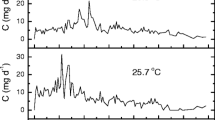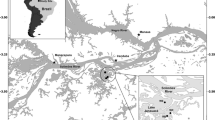Abstract
In-situ partial pressures of hydrogen in anoxic profundal lake sediments reached values of up to 5 Pa which were more than 5 orders of magnitude lower than the partial pressures of methane. Analysis of gas bubbles collected from anoxic submerged paddy soil showed H2 partial pressures in the range of 1.8 ± 1.3 Pa being ca. 4 orders of magnitude lower than the CH4 partial pressures. H2 emission rates, on the other hand, were less than 3 orders of magnitude lower than the CH4 emission rates indicating that H2 and CH4 were oxidized to a different extent in the rhizosphere of the soil before they reached the atmosphere, or that H2 was produced by the plants. More than 70% of the emitted H2 reached the atmosphere via plant-mediated flux. The rest was emitted via ebullition from the anoxic soil and, in addition, was produced in the paddy water. A significant amount of H2 was indeed found to be produced in the water under conditions where thallic algae and submerged parts of the rice plants produced oxygen by photosynthesis. Very little H2 was emitted via molecular diffusion through the paddy water; in addition, this amount was less than expected from the degree of supersaturation and the diffusional emission rate of CH4 indicating a relatively high rate of H2 consumption in the surface film of the paddy water. The total H2 source strength of rice paddies and other freshwater environments was estimated to be less than 1 Tg yr-1, being negligible in the atmospheric budget of H2.
Similar content being viewed by others
References
Bishop, N.I. & L.W. Jones (1978) Alternate fates of the photochemical reducing power generated in photosynthesis: hydrogen production and nitrogen fixation. Current Topics in Bioengineering 8: 3–31.
Bothe, H., G. Neuer, I. Kalbe & G. Eisbrenner (1980) Electron donors and hydrogenase in nitrogen-fixing microorganisms. In: W.D.P. Stewart, J.R. Gallon (Eds) Nitrogen Fixation (pp 83–112). Academic Press, London.
Brock, T.D. (1985) A eutrophic lake system — Lake Mendota. Springer, New York.
Broecker, W.S. & T.H. Peng (1974) Gas exchange rates between air and sea. Tellus 26: 21–35.
Cicerone, R.J. & J.D. Shetter (1981) Sources of atmospheric methane: measurements in rice paddies and a discussion. Journal of Geophysical Research 86: 7203–7209.
Conrad, R. (1984) Capacity of aerobic microorganisms to utilize and grow on atmospheric trace gases (H2, CO, CH4). In: M.J. Klug & C.A. Reddy (Eds) Current Perspectives in Microbial Ecology (pp 461–467). American Society for Microbiology, Washington, D.C.
Conrad, R., M. Aragno and W. Seiler (1983) Production and consumption of hydrogen in a eutrophic lake. Applied and Environmental Microbiology 45: 502–510.
Conrad, R., T.J. Phelps & J.G. Zeikus (1985) Gas metabolism evidence in support of juxtapositioning between hydrogen producing and methanogenic bacteria in sewage sludge and lake sediments. Applied and Environmental Microbiology 50: 595–601.
Conrad, R. & W. Seiler (1982) Utilization of traces of carbon monoxide by aerobic oligotrophic microorganisms in ocean, lake and soil. Archives of Microbiology 132: 41–46.
Conrad, R. & W. Seiler (1986) Exchange of CO and H2 between ocean and atmosphere. In: P. Buat-Menard (Ed) The Role of Air-Sea Exchange in Geochemical Cycling (pp 269–282). Reidel, Dordrecht.
Conrad, R. & W. Seiler (1988) Influence of the surface layer on the flux of non-conservative trace gases (H2, CO, CH4, N2O) across the ocean-atmosphere interface. Journal of Atmospheric Chemistry 6: 83–94.
Dacey, J.W.H. & M.J. Klug (1979) Methane efflux from lake sediments through water lilies. Science 203: 1253–1255.
Dahm, C.N., J.A. Baross, A.K. Ward, M.D. Lilley and J.R. Sedell (1983) Initial effects of the Mount St. Helens eruption on nitrogen cycle and related chemical processes in Ryan Lake. Applied and Environmental Microbiology 45: 1633–1645.
De Bont, J.A.M., K.K. Lee & D.F. Bouldin (1978) Bacterial oxidation of methane in a rice paddy. Ecological Bulletin (Stockholm) 26: 91–96.
Ehhalt, D.H. & U. Schmidt (1978) Sources and sinks of atmospheric methane. Pure and Applied Geophysics 116: 452–464.
Fallon, R.D., S. Harrits, R.S. Hanson & T.D. Brock (1980) The role of methane in internal carbon cycling in Lake Mendota during summer stratification. Limnology and Oceanography 25: 357–360.
Goodwin, S., R. Conrad & J.G. Zeikus (1988) Adaption of anaerobic bacteria to low pH: relation of pH and hydrogen metabolism in diverse sedimentary ecosystems. Applied and Environmental Microbiology, submitted.
Gowda, T.K.S. & I. Watanabe (1985) Variation in the incidence of H2-oxidizing chemolithotrophic bacteria in rice grown under different cultivation conditions. Plant and Soil 85: 97–106.
Hallenbeck, P.C. & J.R. Benemann (1979) Hydrogen from algae. Topics in Photosynthesis 3: 331–364.
Hanson, R.S. (1980) Ecology and diversity of methylotrophic organisms. Advances in Applied Microbiology 26: 3–39.
Holzapfel-Pschorn, A., R. Conrad & W. Seiler (1985) Production, oxidation and emission of methane in rice paddies. FEMS Microbiology Ecology 31: 343–351.
Holzapfel-Pschorn, A., R. Conrad & W. Seiler (1986) Effects of vegetation on the emission of methane by submerged paddy soil. Plant and Soil 92: 223–233.
Holzapfel-Pschorn, A. & W. Seiler (1986) Methane emission during a cultivation period from an Italian rice paddy. Journal of Geophysical Research 91: 11803–11814.
Hutchinson, G.E. (1948) Circular casual systems in ecology. Annales of the New York Academy of Sciences 50: 221.
Koyama, T. (1964) Biogeochemical studies on lake sediments and paddy soils and the production of atmospheric methane and hydrogen. In: Y. Miyake & T. Koyama (Eds) Recent Researches in the Fields of Hydrosphere, Atmosphere and Nuclear Geochemistry (pp 143–177). Maruzen, Tokyo.
Lambert, G.R. & G.D. Smith (1981) The hydrogen metabolism of cyanobacteria (bluegreen algae). Biological Reviews of the Cambridge Philosophical Society 56: 589–660.
Liss, P.S. & P.G. Slater (1974) Flux of gases across the air-sea interface. Nature 247: 181–184.
Molongoski, J.J. & M.J. Klug (1980) Anaerobic metabolism of particulate organic matter in the sediments of a eutrophic lake. Freshwater Biology 10: 507–518.
Nedwell, D.B. (1984) The input and mineralization of organic carbon in anaerobic aquatic sediments. Advances in Microbial Ecology 7: 93–131.
Oremland, R.S. (1983) Hydrogen metabolism by decomposing cyanobacterial aggregates in Big Soda Lake, Nevada. Applied and Environmental Microbiology 45: 1519–1525.
Parkin, T.B., M.R. Winfrey & T.D. Brock (1980) The physical and chemical limnology of a Wisconsin meromictic lake. Wisconsin Academy of Sciences and Arts Letters 68: 111–125.
Rudd, J.W.M. & C.D. Taylor (1980) Methane cycling in aquatic environments. Advances in Aquatic Microbiology 2: 77–150.
Schink, B. & J.G. Zeikus (1984) Ecology of aerobic hydrogen-oxidizing bacteria in two freshwater lake ecosystems. Canadian Journal of Microbiology 30: 260–265.
Scranton, M.I., P.C. Novelli & P.A. Loud (1984) The distribution and cycling of hydrogen gas in the waters of two anoxic marine environments. Limnology and Oceanography 29: 993–1002.
Sebacher, D.I., R.C. Harriss & K.B. Bartlett (1985) Methane emissions to the atmosphere through aquatic plants. Journal of Environmental Quality 14: 40–46.
Sebacher, D.I., R.C. Harriss, K.B. Bartlett, S.M. Sebacher & S.S. Grice (1986) Atmospheric methane sources: Alaskan tundra bogs, an Alpine fen, and subarctic boreal marsh. Tellus 38B: 1–10.
Seiler, W. (1-978) The influence of the biosphere on the atmospheric CO and H2 cycles, p. 773–810. In: W.E. Krumbein (Ed) Environmental biogeochemistry and geomicrobiology, v.3. Ann Arbor Sci Publ., Ann Arbor, MI.
Seiler, W. (1984) Contribution of biological processes to the global budget of CH4 in the atmosphere. In: M.J. Klug & C.A. Reddy (Eds) Current perspectives in Microbial Ecology (pp 468–477). American Society for Microbiology, Washington, D.C.
Seiler, W. (1985) Increase of atmospheric methane: causes and impact on the environment. WMO-Special environmental report # 16, pp. 177–203. WMO, Geneva, Switzerland.
Seiler, W. & R. Conrad (1987) Contribution of tropical ecosystems to the global budgets of trace gases, especially CH4, H2 and N2O. In: R.E. Dickinson (Ed) The Geophysiology of Amazonia (pp 133–162). John Wiley, New York.
Seiler, W., H. Giehl & G. Bunse (1978) The influence of plants on atmospheric carbon monoxide and dinitrogen oxide. Pure and Applied Geophysics 116: 439–451.
Seiler, W., H. Giehl & P. Roggendorf (1980) Detection of carbon monoxide and hydrogen by conversion of mercury oxide to mercury vapor. Atmospheric Technology 12: 40–45.
Seiler, W., A. Holzapfel-Pschorn, R. Conrad & D. Scharffe (1984) Methane emission from rice paddies. Journal of Atmospheric Chemistry 1: 241–268.
Strayer, R.F. & J.M. Tiedje (1978) In situ methane production in a small, hypereutrophic, hard-water lake: loss of methane from sediments by vertical diffusion and ebullition. Limnology and Oceanography 23: 1201–1206.
Torgersen, T., G. Mathieu, R.H. Hesslein & W.S. Broecker (1982) Gas exchange dependency on diffusion coefficient: direct222Rn and3He comparisons in a small lake. Journal of Geophysical Research 87: 546–556.
Wanninkhof, R., J.R. Ledwell & W.S. Broecker (1985) Gas exchange-wind speed relation measured with sulfur hexafluoride on a lake. Science 227: 1224–1227.
Weimer, W.C. & G.F. Lee (1973) Some considerations of the chemical limnology of meromictic Lake Mary. Limnology and Oceanography 18: 414–425.
Zehnder, A.J.B. (1978) Ecology of methane formation. In: R. Mitchell (Ed) Water pollution microbiology. Vol. 2. (pp. 349–376). John Wiley, New York.
Zeikus, J.G. (1983) Metabolic communication between biodegrative populations in nature. In: J.H. Slater & R. Whittenbury (Eds) Microbes in their Natural Environments (pp 423–462). Cambridge University Press, Cambridge.
Author information
Authors and Affiliations
Rights and permissions
About this article
Cite this article
Schütz, H., Conrad, R., Goodwin, S. et al. Emission of hydrogen from deep and shallow freshwater environments. Biogeochemistry 5, 295–311 (1988). https://doi.org/10.1007/BF02180069
Issue Date:
DOI: https://doi.org/10.1007/BF02180069




